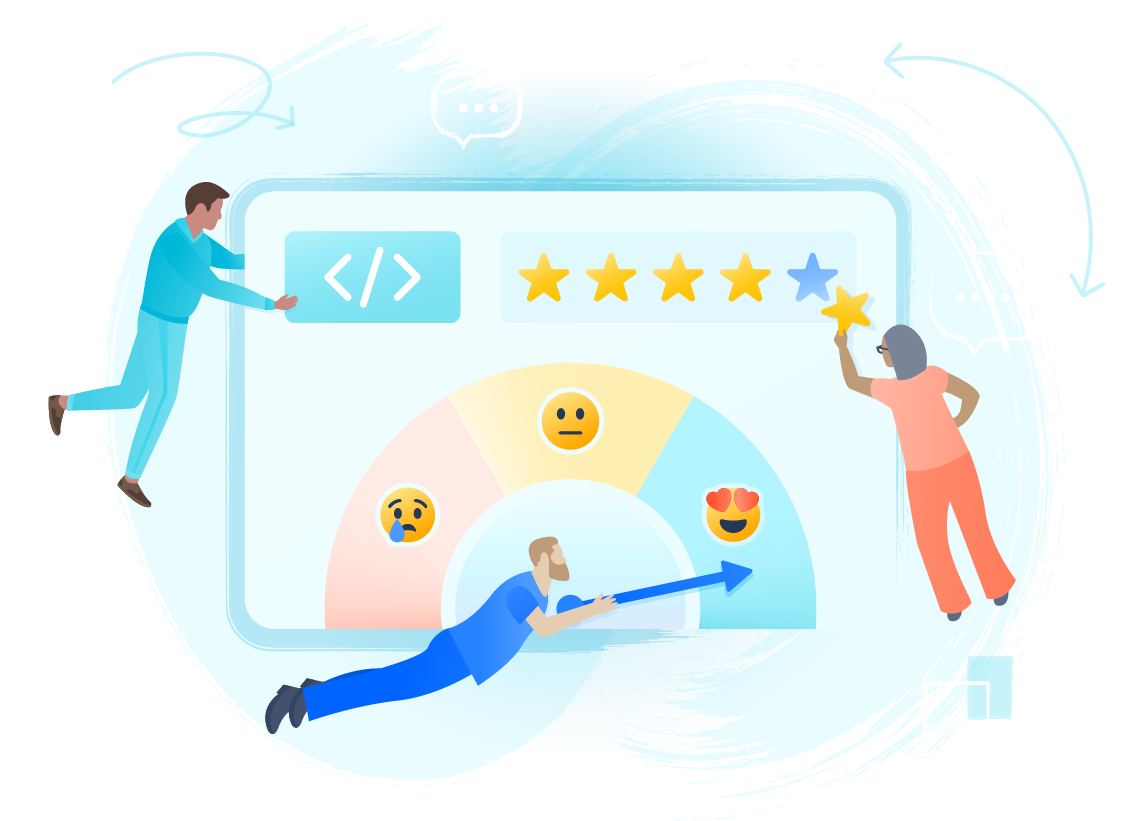Developer experience surveys in action
An example of how you can run your developer experience survey with a survey tool.
Plot survey results on an XY graph using our rating system: red signs need the team’s attention, yellow signs are areas for improvement, and green signs are already well-served.
Use Confluence whiteboards to plot your most pressing vital signs, discuss potential solutions, and plan actions for improving the developer experience.
What you'll need
Remote
Survey tool
Digital collaboration tool
In-Person
Survey tool
Whiteboard, or large sheet of paper
Post-its
Instructions for running this Play
Please note: The most useful developer experience surveys are organization-specific. In the following Play, we include an Atlassian-specific survey. Our survey may work for your team as-is, but we encourage you to adapt the survey to your team and organization as needed.
1. Select your vital signs 30 MIN
To truly understand your team’s developer experience, you need to ask the right questions. At Atlassian, we focus our questions on key vital signs that help us uncover pain points within the developer experience. Vital signs are data points that act as team health and performance indicators. Much like your body’s vital signs, they can quickly identify problems in the system.
Vital signs are a crucial component to this entire Play, so before you begin, come to an agreement with your team about which vital signs are important to your operations. We recommend including six to eight vital signs in your own organization-specific survey.
Here are the eight vital signs that we created for our Atlassian developer experience survey:
- Sustainable speed for shipping: How quickly your team ships high-quality code without developer burnout. This covers the typical development lifecycle from when the developers on your team begin to work on a user story to when a feature is deployed into production.
- Waiting time: The amount of time the developers on your team spend waiting on builds, tests, code reviews, and unnecessary meetings.
- Execution independence: Your team's ability to deliver without depending on other teams, regardless of who owns the code.
- Ways of working: How much effort it takes to discover and onboard a new way of working that your team needs or would benefit from, including tools, frameworks, processes, and practices.
- External standards: The work it takes to meet company standards. These standards are generated externally to your team and are in addition to product requirements like security and compliance.
- Maintenance: The amount of time your team spends maintaining codebase, pipelines, and infrastructure. This work is generated internally by your team.
- Onboarding: How quickly an engineer can become effective after being hired or transferring internally.
- Developer satisfaction: How satisfied engineers are with their productivity.
Incorporate our vital signs into your organization-specific survey, or use ours for inspiration and create your own. If a vital sign doesn’t apply, you can remove it from the survey in step two. When in doubt about a vital sign’s relevance, we suggest leaving it in until you’ve run the Play at least once.
Curious how we created these vital signs?
First, we ran organization-wide surveys to gather data. Then, we applied the principles of outcome-driven innovation from Anthony Ulwick’s book, What Customers Want, to give each vital sign an opportunity score.
2. Run your survey 10 MIN
After you’ve chosen or created vital signs that apply to the developers on your team, prepare your developers for the survey by communicating with them about the purpose of the Play and how you plan to follow up with survey results.
Next, invite all of your devs to complete your survey. Set a clear deadline — we recommend three to seven days.
If you’re unable to require everyone to complete the survey, you may want to capture additional details, such as role level or location. This helps ensure that your results aren’t skewed.
The following survey is based on Atlassian’s vital signs. If you choose to include different vital signs, you’ll need to adjust your survey questions. Ask two questions per vital sign: one about the importance of the vital sign to the developer, and one about how satisfied the developer is with their team’s current ability to deliver on the vital sign. Include a scale with your survey from 0 to 10, where 0 = not important/not satisfied and 10 = very important/very satisfied.
EXAMPLE SURVEY QUESTIONS TO GAUGE THE DEVELOPER EXPERIENCE:
Sustainable speed to ship
- How important is shipping high-quality code sustainably for your team?
- How satisfied are you with your team’s ability to ship high-quality code sustainably?
Waiting time
- How important is minimizing waiting time to your productivity?
- How satisfied are you with the amount of developer waiting time on your team?
Execution independence
- How important do you consider your team's ability to deliver independently of other teams?
- How satisfied are you with your team's delivery independence?
Ways of working
- How important is it for your team to discover and onboard new ways of working, including tools, processes, and practices?
- How satisfied are you with your team’s ability to discover and onboard a new way of working, including tools, processes, and practices?
External standards
- How important to your productivity is the amount of maintenance or platform work it takes to meet the externally generated company standards your team owns?
- How satisfied are you with the amount of maintenance or platform work it takes to meet the externally generated company standards your team owns?
Maintenance
- How important to your productivity is the amount of effort required of you to maintain your team’s standards with regard to code, tools, and pipelines?
- How satisfied are you with the amount of effort required for code, tools, and pipeline maintenance?
Onboarding
- How important to your productivity is the amount of time it takes new hires or internal transfers to become effective on your team?
- How satisfied are you with the amount of time it takes new hires or internal transfers to become effective on your team?
Developer satisfaction
- How important is your satisfaction to your productivity?
- How satisfied are you with your team's developer productivity?
3. Calculate the results 10 MIN
Once everyone’s completed the survey, close it, and review the data.
Next, assign each vital sign an opportunity score. If you have any outliers, call them out in your notes and discuss them with your team. You can use a spreadsheet tool to make your calculations easier, if you’d like.
Here’s how to calculate the opportunity score for each vital sign:
- First, identify the average importance and the average satisfaction of your vital sign.
- For example, 8.22 and 5.88, respectively.
- Next, calculate the difference between the average importance and the average satisfaction.
- For example, 8.22 - 5.88 = 2.34
- Finally, if this number is positive, add it to the average importance to find your vital sign’s opportunity score. If the number is negative, your average importance is your opportunity score.
- For example, 8.22 + 2.34 = 10.56
Opportunity score = importance + max (importance - satisfaction, 0)
Next, take the opportunity score for each of your vital signs and designate a rating:
Tip: MAP OUT YOUR DATA
If it’s helpful to visualize each of your vital signs relative to the others, you can plot your results on a scatter plot.
When to remove a vital sign
If average satisfaction is higher than average importance, the vital sign is probably not very important to your team, or your team is satisfied with it already. In the future, you can replace the vital sign with one you want to watch more closely.
15+: Extremely under-served areas to address first.
10-15: Areas that should be addressed soon.
10 and below: Well-served areas that do not need to be addressed.
We've organized results from a sample survey into a table below.
Sample survey results
Vital sign | Average importance | Average satisfaction | Opportunity score | Results |
|---|---|---|---|---|
| Sustainable speed to ship | Average importance 6.93 | Average satisfaction 4.83 | Opportunity score 9.03 | Results GOOD |
| Waiting time | Average importance 7.48 | Average satisfaction 3.41 | Opportunity score 11.55 | Results IMPROVEMENT NEEDED |
| Execution independence | Average importance 4.56 | Average satisfaction 6.34 | Opportunity score 4.56 | Results GOOD |
| Ways of working | Average importance 8.3 | Average satisfaction 1.33 | Opportunity score 15.27 | Results NEEDS ACTION |
| External standards | Average importance 2.67 | Average satisfaction 5.87 | Opportunity score 2.67 | Results GOOD |
| Maintenance | Average importance 9.15 | Average satisfaction 3.23 | Opportunity score 15.07 | Results NEEDS ACTION |
| Onboarding | Average importance 3.6 | Average satisfaction 9.76 | Opportunity score 3.6 | Results GOOD |
| Developer satisfaction | Average importance 7.82 | Average satisfaction 5.49 | Opportunity score 10.15 | Results IMPROVEMENT NEEDED |
Advanced math
An optional way to get more out of your findings is to calculate the satisfaction gap for each vital sign.
When you find the difference between the average importance and the average satisfaction of each vital sign, you’re calculating the satisfaction gap. That is, the difference between how important a vital sign is to your developers compared with how satisfied they are with it. A smaller satisfaction gap indicates that the vital sign is either of low importance and low satisfaction, or high importance and high satisfaction, and so, in both cases, that vital sign is less of a priority. A larger satisfaction gap indicates a vital sign is both highly important to the team and they currently are not satisfied with how the team manages it, so addressing the issue is a high priority.
4. Meet to discuss results and generate solutions 30 MIN
Finally, discuss the survey results with your team, identify the top three most pressing opportunity areas, and brainstorm solutions together.
To facilitate this important meeting, we recommend creating a Confluence page or Trello board with a simple vital signs table that lists your ratings. This makes for an effective, simple setup to keep remote or hybrid teams aligned. You can mark the most pressing opportunity areas and even share a link to the raw, anonymized responses if you want to dig deeper.
You can also use Confluence whiteboards to create sections for each of your most pressing vital signs and crowd-source potential solutions, as well as add your own thoughts.
- Circle back on ideas to check off the ones you’ll pursue.
- Add action items to the backlog.
- After your meeting, make sure everyone has access to the page and invite developers to continue to add ideas.
This meeting is an important way for the team to demonstrate to developers that their voice matters and can lead to change, which in turn can ensure high survey completion rates going forward. Offering a way for devs to have input can help them feel more invested in the outcome, which often leads to better follow-through and more consistent results. Diverse perspectives create better solutions, and it’s up to everyone to create change and grow, not just leadership.
Tip: DON’T SKIP THIS STEP!
Asking questions and not discussing the outcome is often worse than not asking at all.
Follow-up
We recommend running the Developer Experience Survey Play at least twice each year if you are happy with your success metrics and vital signs, and quarterly if you are actively working on improving your developer experience.
Explore other Plays
Stay up to date
Get the latest Plays and work life advice when you sign up for our newsletter.


.png?cdnVersion=2671)
.png?cdnVersion=2671)
.png?cdnVersion=2671)

